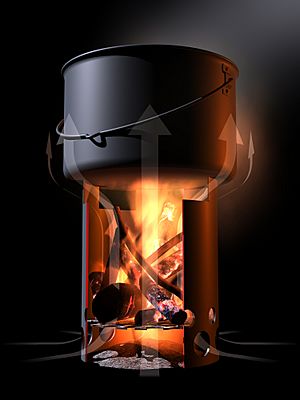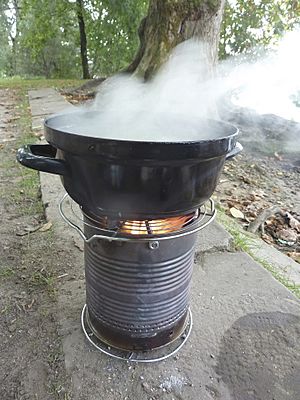Hobo stove facts for kids
A hobo stove is a simple, homemade cooking and heating device. People use them in the outdoors, like when backpacking or in survival situations. They are also useful during power outages. These stoves can boil water to make it safe to drink. They are great for cooking meals outside.
Contents
Building and Using a Hobo Stove
You can make a hobo stove from an old tin can. First, you take off the top of the can. Then, you make several small holes near the top edge. You also need a bigger opening near the bottom on the side. This big hole lets you add fuel and helps air get in. It's best to leave the can's bottom in place. This makes the stove stronger and helps stop fires from spreading on the ground.
To use it, you put fuel inside the can and light it. Air comes in through the bottom hole. This helps the fire burn hotter. Heat then rises out of the top. You can place a pot or pan on top to cook. If you need more heat, turn the bottom hole towards the wind. If the fire is too hot, you can cover part of the hole with a piece of metal.
What Can You Use to Build and Fuel It?
Hobo stoves are easy to build and very flexible. You can make them from many different things. These include paint cans, coffee cans, food tins, buckets, or even large drums.
You can also use almost anything that burns as fuel. Small, dry twigs and pine cones work well. Dried animal waste can also be used. For some stoves, you can use a special burner called a Buddy Burner. This lets you use liquid fuels like rubbing alcohol, kerosene, or wax.
Important Safety Tips
When using a hobo stove, it's very important to be careful.
Choosing Your Can Wisely
Some cans have special coatings inside them. These coatings might contain chemicals that are not good for you. For example, some food cans have a chemical called Bisphenol A (BPA). Cans that held paints or other chemicals can also be risky. Always make sure a can is very clean and safe before you use it for cooking.
Picking Safe Fuel
Be careful about what you burn in your stove. Dry twigs and natural fuels are usually safe. But burning other materials, like wood that has been treated to last longer, can be dangerous. This kind of wood might release harmful chemicals when it burns. These chemicals could make you sick. Always choose your fuel carefully to stay safe.



